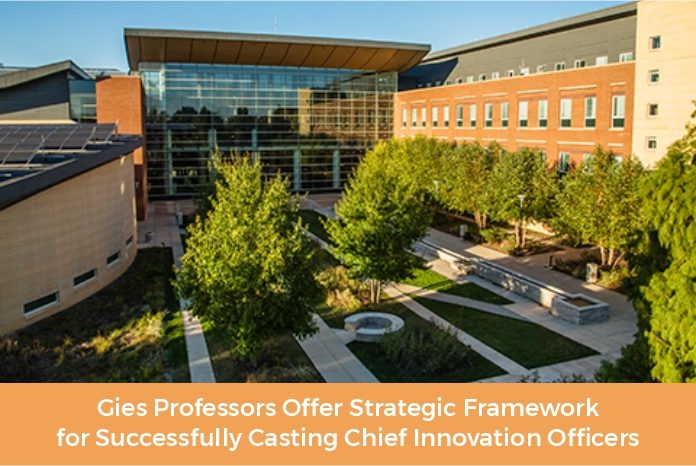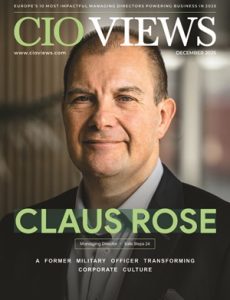Companies often miscast the increasingly popular Chief Innovation Officer (CIO) position, according to new research from Gies College of Business. Professors Joseph Cheng and E. Geoffrey Love identify the roots of the problem and offer an alternative approach that matches the job’s responsibilities to the firm’s competitive positioning in their industry.

“Our research offers a comprehensive, holistic approach to help companies successfully implement the CIO position, which has great promise, but is very challenging to execute,” said Cheng (left), who partnered with Love on the paper, “Designing chief innovation officer positions: a strategic contingency framework,” which was recently published in the Journal of Organizational Design. “Companies often rely on intuition or trial-and-error approaches.”
Twenty years ago, the CIO didn’t exist, but now an estimated 400,000 LinkedIn users bear that title. Yet there has been little research on how to structure CIO positions and support them for success.
“What most companies miss is that innovation is really hard. In its basic form, innovation is creating something new and different that adds value from what already exists,” said Cheng. “But the minute you start experimenting there will be failures. And seven out of 10 executives say they don’t want to suffer short-term consequences because their job is on the line.”
“Naming a Chief Innovation Officer is not a silver bullet; that’s a myth,” added Love. “Companies that buy into that mindset fail. They don’t understand that in order to achieve better results and better products you need to buy into a complex, long-term process.”
Cheng and Love identified tension points to implementing a CIO position in any organization through a roundtable event attended by CIOs and executives in innovation management positions. Participants represented industries ranging from consumer goods to energy to pharmaceuticals. They found that although CIO roles are often associated with expansive goals, they typically have limited power and resources relative to other C-suite executives. They said it is critical for CIOs to actively create and manage expectations for the position and emphasize close collaboration with a range of other executives.
Another finding is that some companies defined the CIO role as exploratory, focused on breakthrough or disruptive innovation. Others were more exploitative in their approach, looking for CIOs to be a bridge between the marketplace and the immediate needs of business units and functions. Balancing between exploration and exploitation in innovation is part of the CIO’s job as companies adapt to external changes.
Cheng and Love also found inherent tension between some that equate the CIO role to evangelism—informing and persuading—and others that look to CIOs for change leadership, playing an activist role in innovation implementation. They said CIOs need to decide when and how to perform each role in ways that fit with the power and support they can expect from other executives.
From these findings Cheng and Love applied relevant concepts from academic literature and developed a strategic contingency framework acknowledging that companies compete in the marketplace in different ways.
Their paper outlines the optimal reporting structure, focus, and responsibilities for CIOs for three main types of companies – defender, prospector, and analyzer (taken from Miles & Snow’s well-established strategic typology):

Defenders are operations-driven companies that emphasize cost effectiveness and efficiency, such as Southwest in the airline and McDonald’s in fast-food industry. While many may expect a CIO to focus on new product development to drive business growth, Cheng and Love (right) recommend CIOs at these firms use their role to identify and integrate new process-related technologies, including customer-related ones. They should also rely on a relatively formal reporting structure and have the authority and budget to implement new initiatives.
Prospectors are market-driven companies that compete to be first in a new product or market. Think Apple, Uber, and Netflix. The CIO’s primary responsibility at these firms should be creating a coherent, synergistic innovation agenda that focuses on novel ideas and prioritizes long-term innovation opportunities that cut across multiple business units, instead of seeking to increase system-wide operational efficiency at the highest level with the latest process-related technologies. CIOs will need to rely on networked leadership to succeed at these types of firms.
Analyzers take a hybrid approach and attempt to compete on both operational efficiency and market effectiveness – companies like Amazon, Samsung, and Spotify. These companies seek balance in developing a competitive advantage on both dimensions, without over-emphasizing one at the expense of the other. Cheng and Love recommend CIOs at these firms chair a Corporate Innovation Committee in charge of technology and process innovations and “new-to-industry” development of products and services. They should rely on a situational mix of formal authority and networked leadership.
For example, Cheng and Love see Southwest Airlines’ recent Christmas meltdown as a classic example of an under-performing Defender firm not having the right process technologies. To bring back lost customers and keep the loyal ones, they recommend Southwest implement a two-pronged, rapid turnaround strategy: First, update existing process technologies across all operational areas to exceed current industry standards for efficiency improvement. Secondly, lower airfares and/or include in the ticket price, without extra cost, service innovations to substantially enhance customer experience before, during, and after flying.
“Lowering airfares in addition to upgrading process technologies would be consistent with a Defender firm’s competitive strategy. Including service innovations to substantially enhance customer experience as an add-on, however, would transform Southwest to an Analyzer firm competing on both operational efficiency and market effectiveness,” said Cheng. “While challenging, either option of this turnaround strategy can be successfully implemented by appointing a CIO with the right qualifications and configuring the position based on the guidelines provided by their strategic contingency framework.”
Companies facing a rapidly evolving competitive landscape would also benefit from a CIO. “For example, some say ChatGPT’s introduction will spark a broad-based revolution in how people do their jobs,” said Love. “Google and Microsoft’s Bingare is already rushing to respond, but how things will evolve is highly uncertain even if the potential is great. “
Cheng and Love believe that a Chief Innovation Officer would clearly be well placed to help firms address the challenge, and their framework could guide those efforts. A CIO at a Defender firm might take the lead in identifying short- and medium-term opportunities to strengthen the firm’s strategic position, and then evangelize these within the top team. They said a CIO at a Prospector firm might instead be aware that at these innovation-friendly firms there is likely to be a number of efforts that emerge organically to take advantage of ChatGPT.
“The CIO’s task would more likely involve connecting these efforts and coalescing support for ideas with potential that cuts across different business units,” said Cheng.
For those working in a firm emphasizing operational efficiency, Cheng and Love recommend hiring a CIO with a technical background and experienced in managing a process function such as IT, supply chain or manufacturing. By contrast, they say CIOs working in a firm that emphasizes market effectiveness would benefit more from having a broader background with prior experience in multiple areas such as strategy, marketing, and R&D.
“Our strategic contingency framework for designing CIO positions presents an interesting contrast with existing approaches to innovation management, which emphasize the importance of decentralized decision making and authority,” said Love. “Instead, we agree with and see benefits in the recent trend to centralize decision making and authority at the C-suite and top management level as an integrating mechanism to create synergy across organizational units’ innovative activities.”
“For the longest time, companies and countries competed on efficiency—who can do more with less will have a competitive advantage and win in the marketplace,” said Cheng. “But now that most companies have become quite efficient, they need to develop a new competitive advantage through relentless innovation.”





